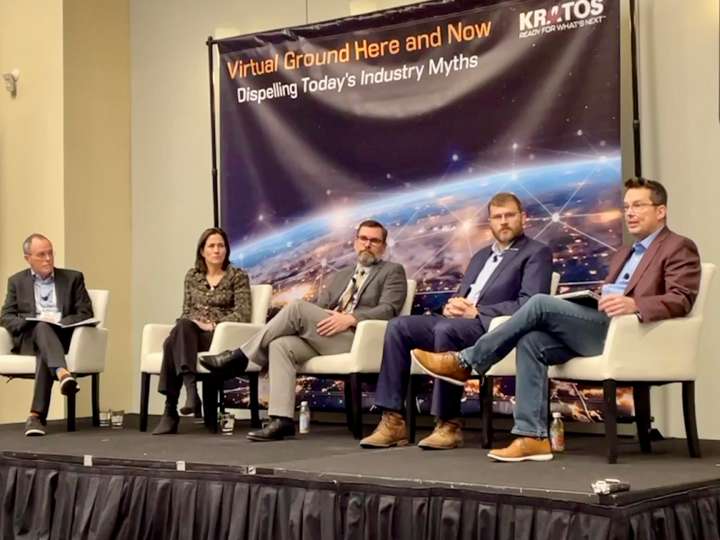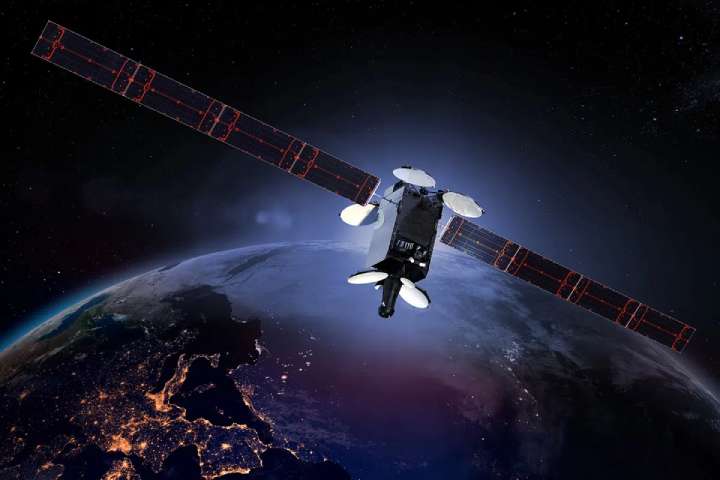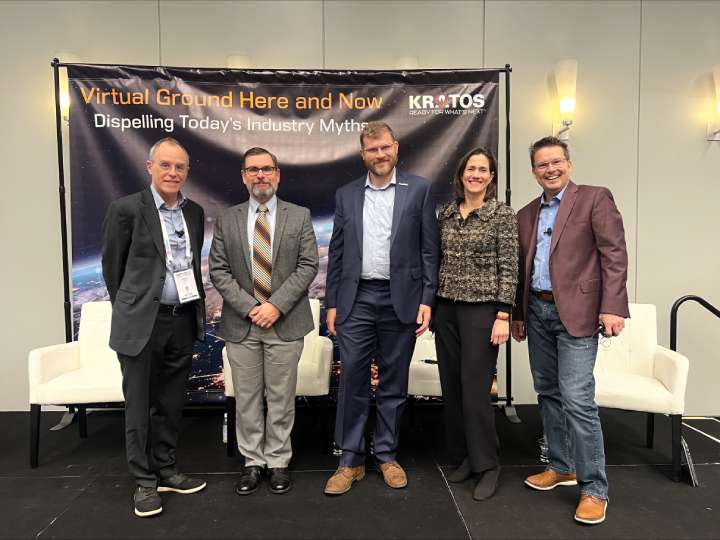WASHINGTON — Ground infrastructure providers have increasingly recognized the need to virtualize today’s purpose-built hardware to support new constellations, high-throughput satellites and tap into terrestrial networks. Given the challenges of virtualizing and orchestrating a satcom ground system, some have claimed the solutions are still “years away.”
 Kratos hosted a breakfast panel on the sidelines of Satellite 2023 in Washington, D.C., March 15, 2023. Panelists from ALL.SPACE, BlueHalo, Intelsat and Kratos addressed the state of virtual ground systems for satellite communications. (Source: Kratos)
Kratos hosted a breakfast panel on the sidelines of Satellite 2023 in Washington, D.C., March 15, 2023. Panelists from ALL.SPACE, BlueHalo, Intelsat and Kratos addressed the state of virtual ground systems for satellite communications. (Source: Kratos)
Companies that are deploying virtual ground infrastructure for satellite communications challenged that idea and other “myths” about next generation ground networks at a breakfast panel hosted by Kratos. Roughly 170 people attended the discussion on the sidelines of Satellite 2023 in Washington, D.C.
Panelists from ALL.SPACE, BlueHalo, Intelsat and Kratos weighed in on “five industry myths” about the alleged limitations of virtual ground systems, signal processing and the cloud. In countering the claims, Kratos Senior Vice President of Product Management Greg Quiggle asserted that:
- The technology for virtual ground is available today and is proven to work on general purpose processors.
- Virtual satcom can be done economically in a cloud environment.
- Implementing digital IF specifications supported by the 60-plus-member Digital Intermediate Frequency Interoperability (DIFI) Consortium can be cost effective.
- Satcom operators using dynamic orchestration can achieve significant gains in network efficiency and resource optimization.
- Security for software-based ground systems is more robust than for legacy boxes.
Why Virtual Ground for Satcom?
While the industry continues to debate the finer points of virtualization, there is little disagreement that it will play a critical role in current and future satellite communications networks.
World Teleport Association (WTA) Executive Director Robert Bell, who moderated the panel, noted that virtual ground architectures will help accelerate the growth and accessibility of commercial satcom. Today, satellite makes up just 1% of the nearly $2 trillion telecommunications market.
“We’re not really talking about technology,” Bell said. “What we’re talking about is adding another $20 billion to satellite’s share of the telecom space.”
Carmel Ortiz, Senior Vice President, Systems Innovation at Intelsat described the need to scale up to meet growing customer demand for ground infrastructure that can match the capabilities of next generation of high-throughput satellites and constellations.
“We’re going to be doubling our global capacity over the next 2-3 years,” she said. “We realized we can’t operate in the same old ways. We cannot do a hardware-based ground infrastructure and operate at the scale that we’re going to need to operate; and that’s particularly true when it comes to talking about the software-defined satellites with the flexible payloads.”
 Intelsat is a leader in global satellite communications and operates a fleet of more than 50 satellites that works in concert with a terrestrial networking infrastructure and managed services. (Source: Intelsat)
Intelsat is a leader in global satellite communications and operates a fleet of more than 50 satellites that works in concert with a terrestrial networking infrastructure and managed services. (Source: Intelsat)
Jeremy Turpin, Chief Scientist and Co-founder of ALL.SPACE described how a software-based ground architecture enabled the company to deploy a demonstration of its intelligent, multi-network terminal and platform at a remote site in Peru. The demonstration seeks to help users leverage multiple satcom networks across orbits and operators.
“There was no way we could physically get access to that system to go set it up,” he said. “The ability to reconfigure on the fly, to control the waveform and to get insight into what our terminal was doing with that waveform…was really powerful.”
Efficiency Beyond Waveforms
Waveforms have always been viewed as the critical element in the overall performance of satcom networks. However, panelists noted that within a virtualized ground system, it’s not the only determinant of network efficiency.
“There is a much broader sense of network efficiency,” said Quiggle. “Dynamic orchestration is what allows you to really be able to tune a network in literally minute-by-minute increments to get peak performance out of all of the infrastructure in the ground system and the gateway.”
This method of software-defined networking for network management and resource allocation is already being used within the space layer.
“The idea of not having to plan in advance where you put beams down even before satellite are launched is really amazing,” said Ortiz, referring to software-defined satcom payloads. “That’s a game-changer, but it requires flexibility on the ground.”
Ortiz noted that customers on the ground are now demanding different types of services, like paying per use, which she said is only possible through end-to-end orchestration and a virtualized ground network.
 ALL.SPACE has developed a modular, software-defined terminal that provides links to multiple satellite and terrestrial networks concurrently from a single device. Image shows the terminal used for communications on the move. (Source: ALL.SPACE)
ALL.SPACE has developed a modular, software-defined terminal that provides links to multiple satellite and terrestrial networks concurrently from a single device. Image shows the terminal used for communications on the move. (Source: ALL.SPACE)
For ALL.SPACE, the challenge of provisioning multiple links to multiple constellations created a similar requirement for dynamic provisioning of resources. Turpin explained that the cost to support multiple waveforms with hardware modems was unfeasible. The hardware quickly added up to exceed the cost of the terminal and updating capabilities meant adding or switching equipment manually.
“By allowing those waveforms to be virtualized and swapped out on the fly without any hardware, joining those networks is no longer a limiting factor,” he said.
Software and the Government Customer
BlueHalo provides advanced technologies across space and ground-based systems to predominantly military and government customers. The company’s Director of Technical Program Management, Jonathan Luminati cited increased demand for flexible, secure and resilient satcom networks, while noting a growing frustration with hardware and software that make it difficult to leverage assets from other vendors across multiple missions.
“That’s something I think we’ll find that on the commercial and the military side is really not acceptable going forward today, because you miss a lot of capability,” Luminati explained.
The nature of a software-based ground system allows users to “squeeze all the efficiency they can” out of a network, he added, while mitigating operational uncertainty. “We don’t know what the next requirement is going to be, but it’s very easy to adapt to that environment when you have this flexibility built in,” Luminati said.
Addressing security in virtual ground systems raises similar issues of adaptability. Traditional hardware-based teleports may run for years without a system update, particularly in hard-to-reach locations. Virtual systems can be updated daily and operators can patch vulnerabilities over the air, without physically touching the teleport.
 From left to right, WTA Executive Director Robert Bell, BlueHalo Director of Technical Program Management Jonathan Luminati, ALL.SPACE Chief Scientist and Co-founder Jeremy Turpin, Intelsat SVP of Systems Innovation Carmel Ortiz and Kratos SVP of Product Management Greg Quiggle. (Source: Kratos)
From left to right, WTA Executive Director Robert Bell, BlueHalo Director of Technical Program Management Jonathan Luminati, ALL.SPACE Chief Scientist and Co-founder Jeremy Turpin, Intelsat SVP of Systems Innovation Carmel Ortiz and Kratos SVP of Product Management Greg Quiggle. (Source: Kratos)
Luminati acknowledged that there are still “religious arguments” at the Pentagon, among other organizations, about whether the software approach increases or decreases the attack surface. “What you come down to at the end of the day…is the updatability,” he said. “You can very rapidly push out upgrades or fixes to problems that might occur, which does not exist in a nominal hardware update cycle.”
Degrees of Virtualization
Currently, a large portion the teleport can be transformed from hardware to software, including channelizers, combiners, modems and the hub. However, not every proponent of virtual ground can cover these functions or provide end-to-end satcom service orchestration.
Most solutions virtualize only select parts of the satcom service chain, like packet processors, network management systems, or modulation and coding (MODCOD). Others use specialized processors (FPGAs and GPUs) that lock users into proprietary systems and make it more difficult to scale.
“It’s all about doing things that we can’t do today on our hardware-based ground systems,” Quiggle continued. “When you do this fully virtualized and fully orchestrated, it really opens the door to a whole new era of business models and scale and performance.”
Explore More:
Digital Ground Pioneers Advancing Multi-Everything Satcom Terminal
Podcast: Virtualization, Cloud and Growth Opportunities for the Teleport
Is Cloud Native Make or Break for Satellite 5G?
